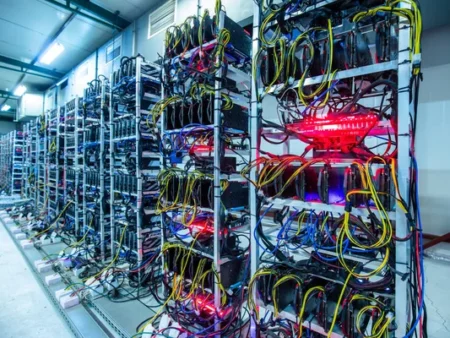Understanding the Basics of Cryptocurrency Mining Explained
Cryptocurrency mining is the process by which new coins are created and transactions are confirmed and added to a blockchain. At its core, mining involves solving complex mathematical problems to validate transactions. Miners use powerful computers to compete against each other, and the first one to solve the problem receives a reward in the form of cryptocurrency. This process not only generates new coins but also secures the network against fraud and double-spending.
The structure of most cryptocurrencies is based on blockchain technology, a decentralized ledger that records all transactions across a network of computers. When miners successfully validate a block of transactions, they add it to the blockchain, ensuring the integrity of the entire network. This decentralized nature is what makes cryptocurrencies resistant to censorship and fraud.
Mining typically requires specialized hardware, such as ASIC (Application-Specific Integrated Circuit) miners, which are designed specifically for this purpose. However, some cryptocurrencies can still be mined using standard computers, though the profitability of doing so often varies significantly.
The competitiveness of mining has increased over the years as more miners enter the space and the difficulty of mining adjusts accordingly. This has led to the formation of mining pools, where multiple miners combine their computational resources to increase their chances of solving blocks and earning rewards.
Overall, cryptocurrency mining is a critical component of the cryptocurrency ecosystem, serving both as a method for generating new coins and as a mechanism for maintaining the security and integrity of the blockchain.
The Role of Miners in Blockchain Technology and Security
Miners play a pivotal role in the functionality and security of blockchain networks. By verifying transactions and adding them to the blockchain, miners ensure that the history of transactions remains immutable and transparent. Each block contains a cryptographic hash of the previous block, linking them together in a secure chain.
Beyond transaction validation, miners also help maintain the network’s decentralized nature. Since mining is open to anyone with the necessary hardware and technical knowledge, it reduces the risk of a single entity gaining control over the entire network. This decentralization is crucial for the integrity and reliability of cryptocurrencies.
Additionally, miners are incentivized to act honestly because the rewards they receive depend on their contributions to the network. If a miner attempts to manipulate the system, they risk losing their investment in hardware and electricity costs. This self-regulatory mechanism fosters a sense of trust within the network.
Moreover, the competitive aspect of mining creates a scenario where miners are motivated to improve their technology and efficiency. This constant innovation leads to advancements in hardware and software, pushing the boundaries of what is possible in the cryptocurrency space.
In summary, miners serve not only as transaction validators but also as protectors of the blockchain’s security and decentralization. Their involvement is fundamental to maintaining the trust and reliability that users expect from cryptocurrencies.
Key Components of Cryptocurrency Mining Hardware and Software
The world of cryptocurrency mining requires a combination of hardware and software to operate effectively. Understanding these components is crucial for anyone looking to enter the mining space.
- Hardware: The primary hardware components include:
- ASIC Miners: These are high-performance machines specifically designed for mining cryptocurrencies like Bitcoin. They offer high hash rates and energy efficiency.
- GPUs (Graphics Processing Units): Commonly used for mining altcoins like Ethereum, GPUs can be more versatile than ASICs, allowing miners to switch between different coins.
- Motherboards and Power Supplies: Essential for building mining rigs, these components must be compatible with the chosen hardware and capable of handling the power demands.
- Software: Mining software connects miners to the blockchain and facilitates the mining process. Common types include:
- Mining Clients: These are essential for communicating with the blockchain network. Examples include CGMiner and BFGMiner.
- Wallet Software: Miners need a wallet to receive and store their earnings. This can be a hardware wallet, software wallet, or an online service.
- Mining Pool Software: If joining a mining pool, specialized software is required to connect with the pool and manage distribution of rewards.
- Cooling Systems: Mining hardware generates significant heat, making cooling systems essential to maintain optimal operating temperatures and prevent hardware damage.
In essence, successful cryptocurrency mining relies on a synergy between powerful hardware and efficient software, along with adequate cooling solutions to ensure ongoing operations. Each component plays a vital role in determining a miner’s profitability and efficiency.
Environmental Impact: The Energy Consumption Debate
The environmental impact of cryptocurrency mining has become a hot topic of debate, particularly in the context of energy consumption. The process of mining, especially for Bitcoin, requires substantial amounts of electricity due to the computational power needed to solve complex mathematical problems.
Critics argue that the energy-intensive nature of mining contributes to increased carbon emissions and environmental degradation. Reports indicate that Bitcoin mining alone consumes more energy than some entire countries. The concern stems from the reliance on fossil fuels in many regions where mining operations are concentrated, leading to calls for more sustainable practices.
In response to mounting criticism, some mining operations are exploring renewable energy sources, such as solar and wind power, to reduce their carbon footprint. For instance, innovative mining farms are being set up in locations with abundant renewable energy, allowing miners to tap into cleaner sources.
Furthermore, the debate extends to the overall sustainability of proof-of-work (PoW) consensus mechanisms, which underpin many cryptocurrencies. Some argue that transitioning to alternative systems, such as proof-of-stake (PoS), could offer a more energy-efficient solution without compromising security.
In conclusion, the environmental impact of cryptocurrency mining is a complex issue that balances the need for secure, decentralized networks with the urgent need to address climate change. The industry’s future may hinge on its ability to adopt greener practices and technologies as it faces increasing scrutiny.
How to Get Started with Cryptocurrency Mining Methods
Getting started with cryptocurrency mining can seem daunting, but breaking it down into manageable steps can simplify the process. Here are some essential steps to consider:
- Choose Your Cryptocurrency: Different cryptocurrencies have varying levels of mining difficulty and profitability. Research which coin aligns with your hardware capabilities and interests.
- Select Your Mining Method: There are several mining methods available, including:
- Solo Mining: Mining independently. This can be rewarding but is often less profitable due to increased competition.
- Pool Mining: Joining a group of miners to combine resources and share rewards, increasing the chances of earning consistently.
- Cloud Mining: Renting mining power from a company, allowing you to mine without managing hardware directly.
- Set Up Your Hardware and Software: Based on your chosen cryptocurrency and mining method, assemble your hardware and install the necessary mining software.
- Join a Mining Pool (if applicable): If you opt for pool mining, research and choose a reputable mining pool that offers transparent reward distribution and low fees.
- Monitor and Optimize: Once set up, continuously monitor your mining operations for efficiency. Keep track of electricity costs, hash rates, and potential software updates to stay competitive.
- Stay Informed: The cryptocurrency space evolves rapidly. Engage with online communities and keep abreast of developments in mining technology, market trends, and regulatory changes.
By following these steps, aspiring miners can navigate the complexities of the cryptocurrency mining landscape and position themselves for potential success.
The Future of Cryptocurrency Mining: Trends and Predictions
The landscape of cryptocurrency mining is continuously evolving, and several trends may shape its future. As the industry matures, various factors will influence how mining operates and its overall sustainability.

- Shift to Renewable Energy: As awareness of environmental concerns grows, more miners are likely to transition to renewable energy sources. This shift not only addresses sustainability issues but also may reduce operational costs in the long run.
- Advancements in Mining Technology: Ongoing innovations in hardware and software will likely enhance mining efficiency. For instance, the development of more powerful ASIC miners and improvements in mining algorithms could lower energy consumption and increase profit margins.
- Regulatory Changes: Governments around the world are beginning to scrutinize cryptocurrency mining more closely. Regulations may emerge that promote sustainable practices or limit mining in certain regions, impacting how and where mining occurs.
- Decentralized Finance (DeFi) Integration: As DeFi gains traction, the relationship between mining and decentralized applications may evolve. Miners may find new opportunities to support DeFi networks while earning rewards.
- Emergence of Alternative Consensus Mechanisms: The rise of proof-of-stake and other energy-efficient consensus mechanisms could challenge traditional proof-of-work mining. These alternatives may offer significant advantages in terms of speed, scalability, and sustainability.
- Community Involvement: As mining becomes more mainstream, community engagement and transparency will be crucial. Miners may need to advocate for fair practices and sustainable initiatives to ensure the long-term viability of the industry.
In summary, the future of cryptocurrency mining is poised for transformation, driven by technological innovations, regulatory developments, and a growing emphasis on sustainability. As these trends unfold, they will shape the mining landscape and determine its role in the broader cryptocurrency ecosystem.
Comparison of Mining Methods
| Mining Method | Description | Pros & Cons |
|---|---|---|
| Solo Mining | Independent mining effort | Pros: Full rewards; Cons: High risk of not earning anything |
| Pool Mining | Joining a group of miners | Pros: Higher chances of earnings; Cons: Shared rewards, lower individual payouts |
| Cloud Mining | Renting mining power | Pros: No hardware management; Cons: Potential for scams, less control |
In conclusion, cryptocurrency mining is a multifaceted and dynamic field that plays an essential role in the security and functioning of blockchain networks. As technology and practices evolve, it is vital for miners and stakeholders to stay informed and adapt to the changing landscape.








